#Hans Eysenck
Explore tagged Tumblr posts
Text
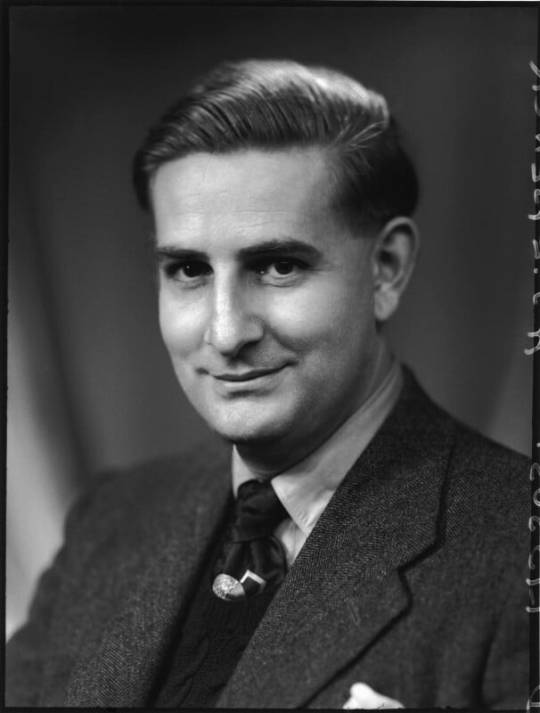
0 notes
Text
Alex Forsythe – Bireysel Farklılıkların Kilit Düşünürleri (2023)
Bu kitap, kişilik, zekâ ve bunların ölçümü alanında çal��şan yetkin psikologların geçmişlerine ve kişisel yaşamlarına bir perde aralıyor. Kitap, psikologların geçmişleri ve özel yaşamlarının onların teorilerini ve sık sık patlak veren tartışmaları nasıl ve neden etkilemiş olabileceğini anlamamıza yardımcı oluyor. ‘Bireysel Farklılıkların Kilit Düşünürleri’, zekâ ve kişilik ölçümlerini…
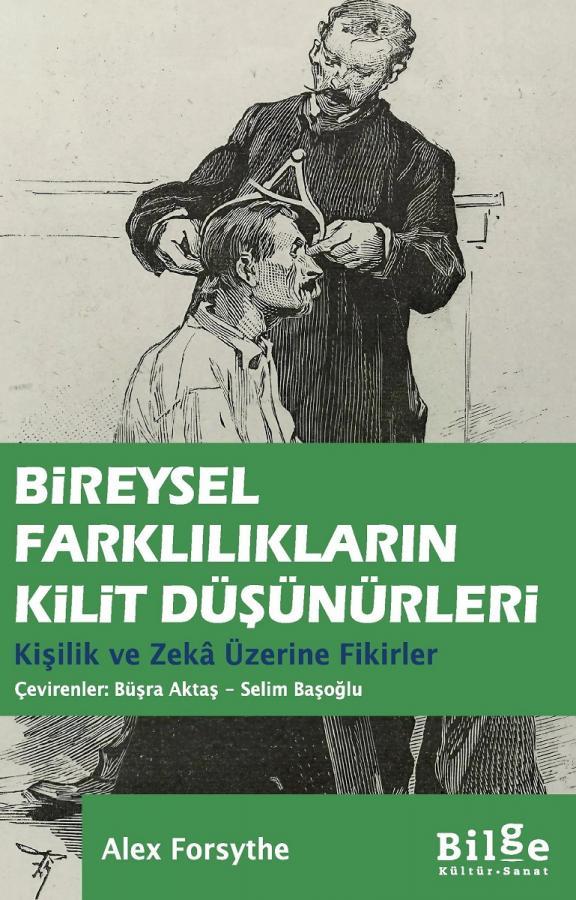
View On WordPress
#2023#Alex Forsythe#Büşra Aktaş#Bilge Kültür Sanat Yayınları#Bireysel Farklılıkların Kilit Düşünürleri#Charles Galton#Hans Eysenck#Isabel Myers#John Philippe Rushton#Karen Horney#Katherine Briggs#Kişilik ve Zekâ Üzerine Fikirler#Selim Başoğlu
0 notes
Text
Writing Notes: Trait Theories

Personality traits reflect people’s characteristic patterns of thoughts, feelings, and behaviors.
Trait theory in psychology rests on the idea that people differ from one another based on the strength and intensity of basic trait dimensions.
3 Criteria that Characterize Personality Traits
consistency,
stability, and
individual differences.
Individuals must be somewhat consistent across situations/settings (e.g., home, work, private life, public persona) in their behaviors related to the trait.
Example: If they are talkative at home, they tend also to be talkative at work.
A trait must also be somewhat stable over time as demonstrated behaviors related to the trait.
Example: At age 30 if someone is talkative they will also tend to be talkative at age 40.
Personality traits will be different from person to person:
People differ from one another on behaviors related to the trait.
People differ on how frequently they talk and so personality traits such as talkative exist.
A major challenge for trait theorists was how to identify traits
They started by generating a list of English adjectives.
Early trait theorists Allport and Odbert identified about 18,000 words in the English language that could describe people (Allport & Odbert, 1936).
The list was later reduced to 4,500 by Allport but even this was far too many traits.
In an effort to make the list of traits more manageable, Raymond Cattell (1946, 1957) narrowed the list to 16 factors and developed a personality assessment called the 16PF.
Later, psychologists Hans and Sybil Eysenck focused on temperament (Eysenck, 1990, 1992; Eysenck and Eysenck, 1963) and hypothesized 2 specific personality dimensions:
extroversion/introversion and
neuroticism/stability.
While Cattell’s 16 factors may be too broad, the 2-factor system proposed by the Eysenck’s has been criticized for being too narrow.
Another personality theory, called the Five Factor Model (FFM), effectively hits a middle ground.
The 5 factors are commonly referred to as the Big Five personality traits (McCrae & Costa, 1987).
It is the most popular theory in personality psychology today and the most accurate approximation of the basic trait dimensions (Funder, 2010).
Traits are scored along a continuum, from high to low rather than present or absent (all or none).
This means that when psychologists talk about Introverts (e.g., quiet, withdrawn, reserved) and Extroverts (e.g., outgoing, social, talkative), they are not really talking about two distinct types of people but rather they are talking about people who score relatively low or relatively high along a continuous dimension.
The 5 Personality Traits
openness to experience,
conscientiousness,
extroversion,
agreeableness, and
neuroticism.
A helpful way to remember the traits is by using the mnemonic OCEAN.
Scores on the Big Five traits are mostly independent which means that a person’s position on the continuum for one trait tells very little about their standing on the other traits.
Examples:
A person can be extremely high in Extraversion and be either high or low on Neuroticism.
A person can be low in Agreeableness and be either high or low in Conscientiousness.
In the FFM you need 5 scores to describe most of an individual’s personality.
Source ⚜ Writing Notes & References
#writing notes#personality#psychology#character development#writeblr#writing reference#dark academia#spilled ink#studyblr#literature#writers on tumblr#writing prompt#poetry#poets on tumblr#creative writing#writing inspiration#writing ideas#light academia#writing inspo#character building#pieter bruegel the elder#art#writing resources
65 notes
·
View notes
Text
Theories of Personality
Theories of personality aim to explain how and why individuals differ in their patterns of behavior, thinking, and emotions. There are several major theories that attempt to describe and categorize personality traits and development.
1. Psychoanalytic Theory (Sigmund Freud)
Core Idea: Freud’s theory of personality revolves around the interaction of the id (basic instincts), ego (rational thought), and superego (moral standards). He believed that personality develops through early childhood experiences and unconscious conflicts.
Structure of Personality: Freud proposed that the unconscious mind plays a key role in shaping behavior and personality, with unresolved internal conflicts influencing behavior.
Defense Mechanisms: Freud also suggested that individuals use defense mechanisms, such as repression or denial, to cope with anxiety and protect their self-image.
Stages of Development: The theory includes psychosexual stages (oral, anal, phallic, latency, and genital stages), with conflicts at each stage influencing adult personality.
2. Humanistic Theory (Carl Rogers, Abraham Maslow)
Core Idea: Humanistic theories emphasize personal growth, free will, and self-actualization. These theories view humans as inherently good, striving to reach their full potential.
Self-Actualization: Maslow's Hierarchy of Needs posits that individuals move through a series of needs, from basic physiological needs to self-actualization, where they fulfill their potential and experience personal growth.
Carl Rogers’ Person-Centered Theory: Rogers introduced the concept of the self-concept, which is how people perceive themselves. He believed that for individuals to achieve their full potential, they need an environment that provides genuineness, acceptance, and empathy.
Unconditional Positive Regard: Rogers argued that receiving unconditional love and acceptance is key to developing a healthy personality and self-esteem.
3. Trait Theory (Gordon Allport, Raymond Cattell, Hans Eysenck)
Core Idea: Trait theories suggest that personality is made up of broad, enduring traits or characteristics that determine behavior.
Gordon Allport: He identified three types of traits: cardinal traits (dominant traits that define an individual), central traits (general traits that form the basic foundation of personality), and secondary traits (more specific traits that appear in certain situations).
Raymond Cattell: Cattell used factor analysis to identify 16 personality factors, suggesting that a combination of these factors defines a person’s unique personality.
Hans Eysenck: Eysenck's model focused on three dimensions of personality: extraversion-introversion, neuroticism-stability, and psychoticism (related to aggressiveness and antisocial tendencies).
4. The Big Five (Five-Factor Model)
Core Idea: The Big Five personality traits are the most widely accepted framework for understanding personality. These traits are thought to exist along a continuum, and people fall at different points within these five dimensions:
Openness to Experience: Creative, curious, open to new ideas vs. traditional, routine-oriented.
Conscientiousness: Organized, responsible, goal-oriented vs. careless, impulsive.
Extraversion: Sociable, outgoing vs. introverted, reserved.
Agreeableness: Cooperative, compassionate vs. antagonistic, competitive.
Neuroticism: Emotionally unstable, anxious vs. emotionally stable, calm.
This model is considered to capture the basic structure of personality across different cultures and contexts.
5. Social-Cognitive Theory (Albert Bandura)
Core Idea: Personality is shaped by the interaction between personal factors (cognitive abilities, beliefs, emotions), behavior, and environment. This is known as reciprocal determinism.
Self-Efficacy: Bandura introduced the concept of self-efficacy, which is the belief in one's ability to succeed in specific situations. High self-efficacy leads to more persistence and confidence in challenging tasks, while low self-efficacy can lead to avoidance of difficult situations.
Observational Learning: Bandura also emphasized the role of modeling and observational learning in personality development, arguing that people learn behaviors and emotional responses by observing others.
6. Behaviorist Theory (B.F. Skinner)
Core Idea: Behaviorists argue that personality is the result of learned behaviors, shaped by rewards and punishments in an individual's environment.
Operant Conditioning: Skinner focused on operant conditioning, where behavior is influenced by reinforcement (positive or negative) or punishment. Over time, individuals develop consistent behavioral patterns based on their experiences with rewards and consequences.
Environmental Determinism: Behaviorists view personality as a product of the external environment rather than internal traits or unconscious forces.
7. Biological and Evolutionary Theories (Hans Eysenck, David Buss)
Core Idea: Biological theories emphasize that personality traits have genetic underpinnings and that human behavior is influenced by evolutionary processes.
Eysenck’s Biological Basis of Personality: Eysenck proposed that personality traits like extraversion and neuroticism are linked to biological differences in brain arousal and functioning.
Evolutionary Psychology: David Buss and other evolutionary psychologists argue that personality traits evolved to solve problems related to survival and reproduction. For instance, traits like aggression or cooperation may have developed as adaptive strategies in human evolutionary history.
8. Cognitive-Behavioral Theory
Core Idea: This theory integrates elements from both cognitive and behavioral psychology. It suggests that cognitive processes (thought patterns, beliefs) play a crucial role in determining behavior and, therefore, personality.
Aaron Beck’s Cognitive Theory: Beck emphasized how automatic thoughts and cognitive distortions (like overgeneralization or catastrophic thinking) shape personality and emotional responses.
Cognitive Restructuring: In cognitive-behavioral therapy (CBT), individuals learn to identify and change negative thought patterns, which in turn influences their behavior and personality over time.
9. Narrative Identity Theory
Core Idea: Narrative identity theory suggests that individuals construct a life story or narrative to make sense of their experiences and define their identity. This narrative evolves over time, reflecting personal growth, values, and social influences.
Dan McAdams: McAdams proposed that personal identity is shaped by the stories we tell about ourselves. People seek coherence and meaning in their life stories, which reflect their personality traits, goals, and values.
This approach emphasizes that personality is not just a set of static traits but an evolving narrative shaped by personal choices and experiences.
10. Existential and Phenomenological Theories
Core Idea: These theories focus on individual experience, freedom, and the search for meaning. Existential psychologists like Rollo May and Viktor Frankl argue that personality is shaped by how individuals confront fundamental existential questions, such as the meaning of life, freedom, and death.
Frankl's Logotherapy: Viktor Frankl emphasized the importance of finding meaning in life, even in suffering, as the central drive in human behavior. He believed that the quest for meaning shapes personality and behavior.
Authenticity and Choice: Existential psychology stresses that individuals are responsible for their own choices, and living authentically means confronting existential realities and making choices in alignment with one’s values.
Theories of personality offer different perspectives on the factors that shape human behavior and individual differences. From Freud’s focus on unconscious drives to the modern trait theories like the Big Five, these approaches explore the intricate dynamics of behavior, thought, and emotion that constitute personality.
#philosophy#epistemology#knowledge#learning#education#chatgpt#psychology#Personality Theory#Psychoanalysis#Humanistic Psychology#Trait Theory#Big Five#Social-Cognitive Theory#Behaviorism#Cognitive Theory#Evolutionary Psychology#Narrative Identity
8 notes
·
View notes
Text


Of course the gambler is like this in the 1959 cigarette psychology test from Hans Eysenck.
2 notes
·
View notes
Text
Criminology: Arousal Theory
Within the study of criminology, the “arousal theory” is most commonly associated with Hans J. Eysenck, who proposed a biosocial theory based on the concept of arousal levels and individual differences in how people react to stimuli, linking it to criminal behavior. The foundational ideas of arousal theory in psychology are often attributed to researchers like Donald B. Lindsley and Robert Yerkes…

View On WordPress
2 notes
·
View notes
Text
every now and then I remember that Oxford short intro book that namedropped Hans Eysenck as an important researcher in the fun field of psychology of personality. just egregiously irresponsible. I would think more would get done to ruin the dude's reputation with the general public but stuff like that just lingers in the culture
1 note
·
View note
Text
i now understand why it is so hard to hold back when you're writing about a topic you're interested in
because im trying so hard to keep myself from giving my Theories of Personality professor John Kramer's whole biography in this paper that has to do with Hans Eysenck's and Carl Rogers' personality theories
Like I do have to share about how John became the man he is but I also have to keep from making a whole page about why he's so messed up
0 notes
Text
LEGADO
Aaron T. Beck: Aaron T. Beck es el creador de la terapia cognitiva, un enfoque terapéutico que se basa en la modificación de patrones de pensamiento disfuncionales. Eysenck contribuyó al desarrollo de la terapia cognitivo-conductual, y su trabajo en este campo podría haber influido en la obra de Beck.
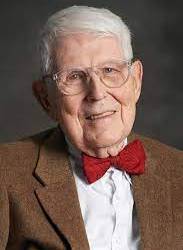
Hans Jürgen Eysenck (hijo): Hans Jürgen Eysenck, hijo de Hans Eysenck, también se convirtió en un psicólogo influyente y siguió trabajando en el campo de la personalidad y la psicometría.
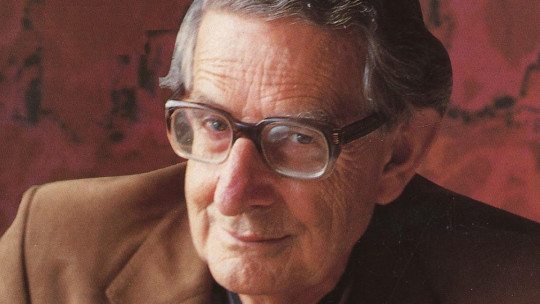
0 notes
Text
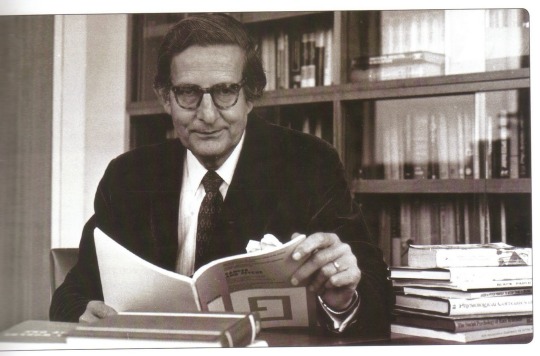
#Hans Eysenck#library#academia#social science#political science#psychology#photography#vintage#glasses#men's fashion#black and white
0 notes
Text
"Creativity is very messy.
...
The creative process-- from the first drop of paint on the canvas to the art exhibition-- involves a mix of emotions, drives, skills, and behaviors. It'd be miraculous if these emotions, traits and behaviors didn't often conflict with each other during the creative process, creating inner and outer tension. Indeed, creative people are often seen as weird, odd, and eccentric.
...
So how can we possibly bring order to the messy minds of creators? A new paper offers some hope. Psychologists Guillaume Furst, Paolo Ghisletta and Todd Lubart present an integrative model of creativity and personality that is deeply grounded in past research on the personality of creative people.
Bringing together lots of different research threads over the years, they identified three "super-factors" of personality that predict creativity: Plasticity, Divergence, and Convergence.
...
Divergence consists of non-conformity, impulsivity, low agreeableness, and low conscientiousness. People high in divergence may seem like jerks, but they are often just very independent thinkers. This super-factor is close to Hans Eysenck's concept of "Psychoticism". Throughout his life, Eysenck argued that these non-conforming characteristics were important contributors to high creative achievements." ( 1 )
I just create my own echo chamber of self-justifications, don't we all...
0 notes
Photo






Happiness: Is Feeling Content More Important Than Purpose and Goals?
There are many ways to be happy, but we can also find comfort in the knowledge that our constant dissatisfaction is what makes us human.
The Conversation Rafael Euba
Don’t worry, be happy.
There is much written about finding one’s life purpose and reaching self actualisation, but do we really need to have one? My partner is happy pottering around the house with his family around him, watching TV, reading the news, working in his unskilled job without responsibility, supporting his football team. Meanwhile, I am frustratingly “growing and developing”, learning, wondering what it is all about – yet without much actually changing in my life. Are drifting and feeling contented in life more important than having a “life purpose” and goals? —Brenda, Blackpool
Questions about happiness, purpose and goals remind me of Don Quixote, the dreaming knight in Cervantes’ novel of the same name, and Sancho Panza, his earthy page. Indeed, literature often contains characters and themes that reflect telling universal truths about human existence, experience – and psychology.
As the novel progresses, we realise that both characters are equally sophisticated intellectually. But while Don Quixote’s goals are utopian, romantic and clearly unobtainable, Sancho is satisfied with feeling safe and eating bread and cheese – accompanied by a little wine, of course – after each of their frustrated misadventures.
I’m a psychiatrist and research on personality shows that a more open and inquisitive personality will always want to seek new experiences and sensations. This is more exciting, but also less comfortable, than rejecting what feels strange or unfamiliar.
Don Quixote’s sensation-seeking and restless personality, as well as his lofty ideals, are the drivers of his misguided adventures. Unable to find excitement in the comfortable but mundane daily life of a landed country gentleman, he sets out to right all the wrongs in the world in the most chivalrous and valiant manner he can imagine. His ambitious goals are unobtainable, though, and so he remains chronically dissatisfied.
In contrast, Sancho’s goals (cheese and wine) are simple, and they are also reliable and immediately achievable. Sancho will inevitably have some difficult emotions, like every other human, that will prevent him from being consistently happy. But he will be less inclined to express his occasional periods of distress in complex existential terms – and they are unlikely to nag and torture him in the same way.
On one level, then, Sancho’s personality seems better suited than Don Quixote’s for achieving a satisfactory level of psychological wellbeing. But we need to consider the fact that Quixote’s tortured loftiness will also afford him occasional moments of ecstasy that Sancho will never experience. Quixote will sample all the many wondrous highs – and lows – of existence.
Choleric Quixote
Quixote has a type of personality that Galen, the Greek physician of classical times, would have labelled as “choleric”: passionate, charismatic, impulsive and sensation seeking. He also has an extremely rich, but equally unstable, inner life, which produces copious amounts of fantasy and emotion.
Soon after the second world war, a London-based psychologist called Hans Eysenck developed another personality theory that included the dimensions of extroversion and neuroticism. Quixote is high in extroversion (he engages constantly with the external world) and high in neuroticism (his emotional life is unstable and intense), a combination that would be the equivalent of Galen’s choleric personality.
Sancho is, of course, the exact opposite. He could be described as “phlegmatic” in Galen’s classification: he is generally introverted, and being perfectly steady in emotional terms, he would certainly score very low on neuroticism. He does not view the world through the filter of a rich but volatile inner life, and instead sees ordinary windmills where Quixote sees formidable giants.
Don Quixote and Sancho Panza. Photo from Shutterstock.
Personality types have been found to be predictors of psychological wellbeing in a way that could be considered relatively intuitive. Essentially, there is a positive correlation between happiness and extroversion and a negative one between happiness and neuroticism. Quixote is more neurotic than Sancho, but he is also more extroverted. The two will find and experience moments of happiness in different ways.
On one level, what we need to be happy is a stable (low neuroticism) and outgoing (extrovert) character. But that’s not the whole story. Those of us who see ourselves as a little more neurotic than we would ideally like – and perhaps not quite as sociable as some others – can find comfort in the knowledge that a busy and lively inner life, coupled with an inquisitive nature, can be associated with certain types of creativity.
The idea of happiness as a state of placidity and serenity, facilitated by a stable and untroubled psychological makeup, is persuasive. But it ignores perhaps the upper and more intense limits of human experience – and these have a power all their own. Cervantes novel, after all, is called “Don Quixote”, not “Sancho Panza”.
Self-Actualisation
You also mention “self-actualisation” in your question. When Abraham Maslow, the celebrated American psychologist, placed self-actualisation at the top of his hierarchy of human needs, he thought of it as a positive drive for developing one’s personal potential. Your own personal potential, Brenda, will be different to that of your partner.
Maslow’s Hierarchy of Needs. Credit: Factoryjoe via Wikimedia Commons, CC BY-SA.
Maslow thought that more basic needs had to be satisfied before moving up to the next level – water and food before safety, then love, self-esteem and only then self-actualisation. But subsequent research shows that humans don’t always do this in the anticipated order and that satisfying different levels of need either simultaneously, or in the “wrong order”, doesn’t seem to affect wellbeing significantly. This explains how those living in poor countries can also satisfy their psychological needs even when the fulfilment of more basic needs is uncertain.
In any case, having a set of needs – hierarchical or not – inevitably puts us in a needy position, and the relationship between striving to better ourselves and happiness is not a simple one. Maslow himself struggled in his personal life with issues such as racism (he was Jewish) and an awful relationship with his mother, whom he hated.
Pain and Pleasure
Research shows that factors such as poverty, pain and loneliness make us unhappy, and it is equally clear that pleasures of any kind contribute towards our sense of wellbeing.
The 19th-century British thinker John Stuart Mill postulated in simple terms that happiness is “intended pleasure, and the absence of pain” while unhappiness is “pain, and the privation of pleasure”.
Like Maslow and his hierarchy of needs, Mill also saw a similar hierarchy in pleasure, with the physiological at the bottom and the spiritual at the top. He also advised against too much introspection in matters of happiness, saying:
Ask yourself if you are happy and you cease to be so.
I suspect you ask yourself this question at times, Brenda. And even though Mill saw happiness as being predicated by pleasure and pain, he also hinted that being human, with all that this implies, may bring a dissatisfaction that would be preferable to mere contentment.
Don Quixote is a dissatisfied man and his ambitions to achieve his glorious goals are always frustrated. He has, however, certain characteristics that have been found to be associated with happiness: an optimistic attributional style and an internal “locus” (place) of control.
The key to happiness? Photo from Shutterstock.
Don Quixote’s “internal locus of control” means that he feels in control of his destiny (despite all the evidence to the contrary). Control resides within him. His “optimistic attributional style”, meanwhile, refers to the fact that he always ascribes his failures to transient external forces, rather than to permanent internal issues.
Sancho, on the other hand, has a reactive attitude to life. He doesn’t have any fantasies about being in control of his destiny, which he believes is in the lap of the gods. “The lucky man has nothing to worry about,” he says.
So, in this respect at least, Don Quixote, driving his own fortune and making his own luck, is probably happier in his quest, however frustrating, than Sancho is in his passive contentment.
Contentment Versus Happiness
The difference between contentment and happiness, or to be more precise, the incompatibility that exists between a state of permanent contentment and being human, has also been explored in modern novels, written centuries after Miguel de Cervantes’ Don Quixote, such as The Time Machine by HG Wells or Brave New World by Aldous Huxley.
Some of the characters in these future dystopias, where pain and suffering have been eradicated, are perfectly placid, even content. But their insipid pseudo-happiness, devoid of choice or intense emotion, is less desirable than our own imperfect emotional tribulations – at least according to the authors.
Indeed, our ability to feel happy is affected by a variety of personality factors and temperamental attitudes, not by just one single dimension of placidity versus psychological restlessness, or even optimism versus pessimism.
But does it matter anyway? Whether we are “half-empty” or “half-full” personalities, none of us is designed to be happy – only, ultimately, to survive and reproduce. Consequently, we will all battle with frequent unpleasant emotions, whatever our temperament.
It is good, Brenda, that you haven’t given up your efforts to grow as a person and that you remain hungry for knowledge. Even if I told you that there is a better strategy for happiness, that you should be content with watching television and little else, I am pretty certain you wouldn’t want that.
You need to continue being who you are, even if being who you are doesn’t transport you to a state of sustained and uninterrupted psychological bliss. Our nature is to chase the teasing and elusive butterfly of happiness, not always to capture it. Happiness can’t be bottled and bought and sold.
It can, however, be a journey – and this never-ending quest includes you, Brenda, as well as your partner. And perhaps we can all find comfort in the knowledge that our nagging dissatisfaction is a key part of what makes us human.
Rafael Euba is a Consultant and Senior Lecturer in Old Age Psychiatry at King's College London.
Advertisement
More from The Conversation
Psychopaths versus sociopaths: what is the difference?206 saves
The ‘real you’ is a myth – we constantly create false memories to achieve the identity we want854 saves
Why bad moods are good for you: the surprising benefits of sadness373 saves
https://getpocket.com/explore/item/happiness-is-feeling-content-more-important-than-purpose-and-goals?utm_source=pocket-newtab
0 notes
Text
How the CIA backed research on mind control
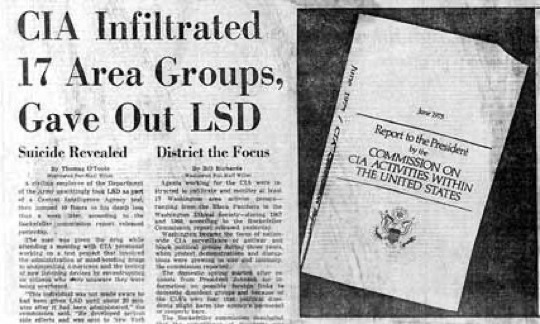
David Dickson March 15 1979 Nature Vol. 278 David Dickson reports on recent revelations about the Central Intelligence Agency's support for university research
In the late 1950s and early 1960s, the US Central Intelligence Agency mounted a comprehensive and well-planned effort to encourage university scientists to carry out research that would, the agency hoped, lead directly to techniques for controlling the human mind.
According to previously classified documents, the agency was responsible for initiating or supporting research that led subsequently to important contributions in various fields of behavioral science, including sociolinguistics, psychotherapy, and personality assessment.
And in an effort to legitimize its interest and obtain access to leading investigators, the agency financed a funding organization that provided grants to a number of prominent members of the scientific community including Carl Rogers, B. F. Skinner, and Professor Hans Eysenck even though the researchers were frequently unaware of the true source of their support.
The details of the CIA's involvement in these fields, described as helping to "liberate the behavioral sciences from the world of rats and cheese," are provided in a book which has just been published in the US by Mr. John Marks, a former Senate aide and State Department official. (The book will appear in the UK later this year.)
Using documents obtained through the Freedom of Information Act, Mr. Marks has put together a detailed picture of how the agency used the academic community in its search for the holy grail: a technique that would provide sufficient manipulation of the human mind to eliminate uncertainty from the intelligence business.
Many of the more bizarre, farcical, or outrageous aspects of this pursuit have since received wide publicity. These range from experiments that switched the East Coast academic community on to LSD, to the construction of a bugged San Francisco brothel (and included a scheme to make Fidel Castro's beard fall out).
But behind these there was, as Mr. Marks shows, a closely considered plan for deriving, through the extension of conventional research techniques and the often unknowing cooperation of university scientists, the type of information that the CIA could use for controlling the behavior of its agents and others.
Much of this research was financed through an organization known as the Society for the Investigation of Human Ecology, set up at Cornell University in 1955 under the guidance of Dr. Harry Wolff, professor of neurology and psychiatry, who was later to become president of the American Neurological Association.
Dr. Wolff's aim, which received considerable sympathy in various academic circles of the time, was to provide a framework for the multidisciplinary study of man in relation to his environment. The CIA's interest was sufficient for it to provide 90% of the society's funding until, having separated from Cornell in 1957 to obtain "more established stature in the research community," the organization was folded in the mid-1960s.
Some of the research funded through the society had a direct and obvious relation to the agency's interests. It provided Wolff himself with a research grant of $74,000 to study the factors that cause men to defect from their countries and cooperate with a foreign government. In other cases, the concerns were more basic. Professor Charles Osgood, for example, who had asked the CIA to support his research into the way people in different societies express similar feelings, received $192,975 over five years through the society. He later completed his influential work on cross-cultural meaning on a grant from the National Institute of Mental Health.
In some cases, the CIA used research grants explicitly to build up the prestige of the Human Ecology Society. Thus, the society provided $26,000 to Professor Eysenck of London University to support his work on motivation; the agency accepted that the research would have "no immediate relevance to agency needs", but the society took funding credit for nine of his publications in its 1963 report. "It's news to me," said Professor Eysenck. Often the research workers were unaware of the source of the majority of the society's funds; some were told that the money came from rich New York doctors or Texas millionaires. "I don't like secret involvement of any kind. I can't see why it could not have been open and above board," says Professor B. F. Skinner, who received $5,000 towards the research leading to his book Freedom and Dignity.
But as well as providing academic respectability, funding of research through the society allowed the CIA legitimately to approach "anyone in the academic community", as one source put it. Thus, in a move that Mr Marks describes as "turning scholars into spies", the society provided $15,000 towards a tour of the Soviet Union by ten prominent psychologists (only one of whom knew of the agency's involvement), and CIA officials debriefed the group on its return.
Support for university behavioural research was curtailed in the mid-1960s. However, in contradiction of testimony later given to Senate committees, the research itself was continued, although with a greater emphasis on more direct ways of influencing behaviour, such as inserting electrodes in the brain. (At one point, agency scientists considered the potential of genetic manipulation: "The rest of the world didn't ask until 1976 the type of questions we were facing in 1965", one agency source is quoted as saying.)
Mr. Marks admits that much of the research which the CIA sponsored led to important contributions to accepted academic knowledge- possibly because the agency was free to take imaginative leaps denied to more conservative (or more democratic) agencies. But he is uncompromising in criticising the ethical basis under which many of the experiments were carried out. (This was not always the agency's fault; some scientists had to be restrained from taking their experiments on, for example, sensory deprivation to their "terminal" conclusion.)
"We as a country can defend ourselves without sending our own scientists--mad or otherwise-into a hidden war that violates our basic ethical and constitutional principles. The time has come for the United States to lead by example by voluntarily renouncing secret government behavioural research," Mr Marks writes in his conclusion.
#mind control#brainwashing#cia#mkultra#counterinsurgency#john marks#parapolitical#parapolitics#lsd#human ecology fund#human ecology foundation
0 notes
Text
Thema 8 Stimm- und Sprechwirkung
VOKAL FRY / KNARRSTIMME
Vocal Fry oder auch Knarrstimme genannt, entsteht durch eine geringe Längsspannung, Verengung (Laryngalisierung) und daraus resultierende unregelmäßige Schwingung von kurzen und dicken Stimmlippen. Starke Adduktion und mediale Kompression ermöglichen nur die Schwingung im vorderen Bereich der Stimmlippen mit plötzlicher Schließung und andauernden Schließungsphasen. Der knorpelige Teil der Glottis ist fest geschlossen, während ein Teil der muskulösen Glottis offen ist und mit geringer Amplitude vibriert.
Vocal Fry kann in manchen Fällen stimmschädigend sein. Es wird in sprachlichen Interaktionen verwendet, u.a. um Absatz- und Satzgrenzen zu markieren. Jedoch kann die Knarrstimme auch schlechter verstanden oder gehört werden. Die tiefere Tonlage des Vocal Frys und abweichende Grundfrequenz kann als weniger natürlich oder vertrauenswürdig wahrgenommen werden von dem gegenüber, vor allem bei weiblichen Sprecherinnen (18-46 Hz). Diese Abweichung von der modalen Intonation führt teilweise zu von Vorurteilen behafteten Annahmen wie fehlender Bildung, Kompetenz oder Attraktivität und kann daher z.B. auf dem Arbeitsmarkt zum Nachteil sein für Sprecher*Innen mit Knarrstimme. Dessen ungeachtet kann eine tiefe Stimme auch positiv mit Autorität und Dominanz assoziiert werden.
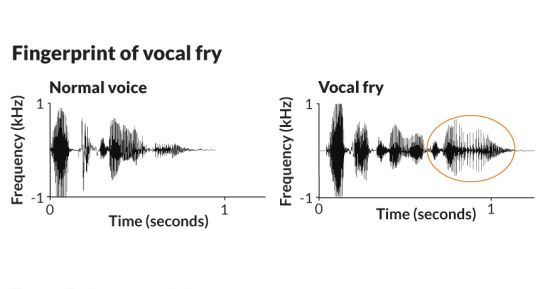
STIMME UND PERSÖNLICHKEIT
Per allgemeiner Definition sind die Stimme Ausdrucksmittel unseres menschlichen Wesens und die Persönlichkeit die Verkörperung unserer selbst. Seit der Antike wurden durch aufgestellte Theorien über die Persönlichkeit wie die “Humoraltheorie”, der später daraus abgeleiteten “Vier - Temperamenten Typologie” von Hans J. Eysenck und verschiedener Persönlichkeitstests (z.B. Big Five oder Myers Briggs Test) Menschen und ihre Persönlichkeit kategorisiert.
("Big Five" Modell, Test dazu auf www.test123.com)
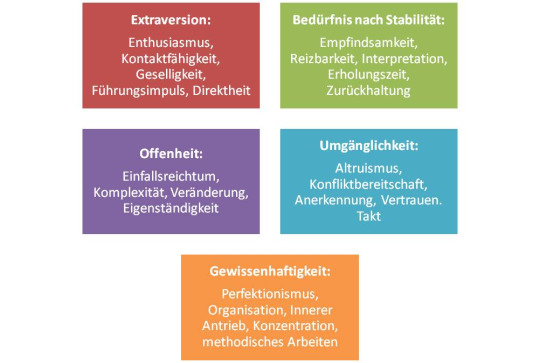
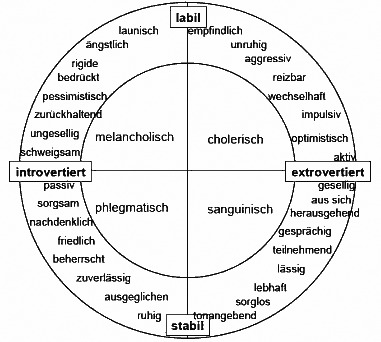
("Vier - Temperamenten - Typologie" nach Hans J. Eysenck)
Persönlichkeitsbeurteilung
Anhand eines stimmlichen Parameters kann man Stimmen und deren Perzeption festmachen. In der Regel werden charakteristische stimmliche Abweichungen von der Norm der jeweiligen Zuhörer- und Sprechergemeinschaft negativ aufgefasst und bewertet. Stimmen werden mit Persönlichkeitsmerkmalen verbunden, sodass wir aus der Stimme des*der Sprecher*in ´eine Persönlichkeit und unsere eigene visuelle Vorstellung ableiten.
Es wird beurteilt nach:
Grundfrequenz f0 und Pitch
Lautstärke und Intensität
Vocal Fry/Laryngalisierung
Behauchung
Rauheit
Intonation
Eine durchschnittliche Stimmhöhe wird als natürlich und angenehm wahrgenommen.
Tiefe Stimmen bei Männern wirken kompetent, offen, durchsetzungsfähig und mutig.
Eine deutliche Intonation wird assoziiert mit Qualitäten wie Kompetenz, Selbstbewusstsein und Temperament. Spricht man nämlich in monotoner Stimmlage ohne variierende Tonhöhen, wird es als langweilig und einschläfernd empfunden.
Zu kleine Resonanzräume und geringe Lautstärke werden als Verschlossenheit oder Schüchternheit aufgefasst. Wenn da noch ein großer Teil an Flüster- und Rauschanteilen mitwirkt, wird dieser Eindruck umso mehr verstärkt.
Eine Knarrstimme gepaart mit Rauheit kann ein Zeichen von Wut oder Aggressivität sein.
Nasale Stimmen können in der Wahrnehmung als Arroganz empfunden werden.
Quellen:
Vocal Fry, (2014) abgerufen am 25.01.2023., von: https://www.sciencenews.org/article/vocal-fry
Audite Vocem, (o.D), abgerufen am 29.01.2023, von: https://www.coli.uni-saarland.de/groups/BM/phonetics/audite_vocem_22/audite_stimm.html
Mein Selbstversuch: Das Big-Five Persönlichkeitsmodell, (04.05.2012.) abgerufen am 12.02.2023, von: https://www.svenja-hofert.de/fuehrungundorganisation/mein-selbstversuch-das-big-5-personlichkeitsmodell/
Gesamtsysteme, (o.D.) abgerufen am 10.03.2023, von: http://www.verhaltenswissenschaft.de/Psychologie/Personlichkeit/Gesamtsysteme/gesamtsysteme.htm
Referat und Folien von Cosima Johne, Constanze Schacht und Hanna Finkmann.
Referat und Folien von Carolin Kühn
0 notes
Text
"Psychoanalysis is at best a premature crystallization of spurious orthadoxies; at worst, a pseudo-scientific doctrine that has done untold harm to psychology and psychiatry alike, and that has been equally harmful to the hopes and aspirations of countless patients who trusted its siren call. The time has come to treat it as a historical curiosity, and to turn to the great task of building up a truely scientific psychology."
Hans Eysenck
Decline And Fall Of The Freudian Empire
#hans eysenck#h j eysenck#decline and fall of the freudian empire#freud#sigmund freud#pseudoscience#books#quotes#psycology#science#critisism#mine
2 notes
·
View notes
